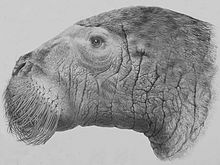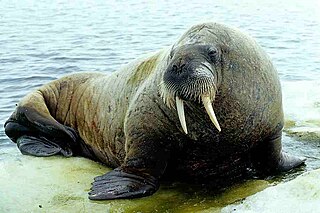
Odobenidae is a family of pinnipeds. The only extant species is the walrus. In the past, however, the group was much more diverse, and includes more than a dozen fossil genera.

The walrus is a large pinniped marine mammal with discontinuous distribution about the North Pole in the Arctic Ocean and subarctic seas of the Northern Hemisphere. It is the only extant species in the family Odobenidae and genus Odobenus. This species is subdivided into two subspecies: the Atlantic walrus, which lives in the Atlantic Ocean, and the Pacific walrus, which lives in the Pacific Ocean.

An eared seal, otariid or otary is any member of the marine mammal family Otariidae, one of three groupings of pinnipeds. They comprise 15 extant species in seven genera and are commonly known either as sea lions or fur seals, distinct from true seals (phocids) and the walrus (odobenids). Otariids are adapted to a semiaquatic lifestyle, feeding and migrating in the water, but breeding and resting on land or ice. They reside in subpolar, temperate, and equatorial waters throughout the Pacific and Southern Oceans and the southern Indian and Atlantic Oceans. They are conspicuously absent in the north Atlantic.

Marine mammals are aquatic mammals that rely on the ocean and other marine ecosystems for their existence. They include animals such as seals, whales, manatees, sea otters and polar bears. They are an informal group, unified only by their reliance on marine environments for feeding and survival.

Pinnipeds, commonly known as seals, are a widely distributed and diverse clade of carnivorous, fin-footed, semiaquatic, mostly marine mammals. They comprise the extant families Odobenidae, Otariidae, and Phocidae. There are 34 extant species of pinnipeds, and more than 50 extinct species have been described from fossils. While seals were historically thought to have descended from two ancestral lines, molecular evidence supports them as a monophyletic lineage. Pinnipeds belong to the order Carnivora; their closest living relatives are musteloids, having diverged about 50 million years ago.
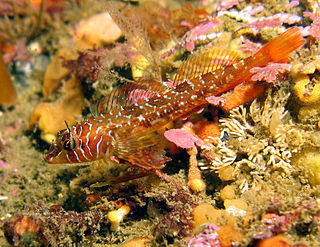
An aquatic animal is any animal, whether vertebrate or invertebrate, that lives in water for all or most of its lifetime. Many insects such as mosquitoes, mayflies, dragonflies and caddisflies have aquatic larvae, with winged adults. Aquatic animals may breathe air or extract oxygen from water through specialised organs called gills, or directly through the skin. Natural environments and the animals that live in them can be categorized as aquatic (water) or terrestrial (land). This designation is polyphyletic.

A flipper is a broad, flattened limb adapted for aquatic locomotion. It refers to the fully webbed, swimming appendages of aquatic vertebrates that are not fish.

Caniformia is a suborder within the order Carnivora consisting of "dog-like" carnivorans. They include dogs, bears, raccoons, and mustelids. The Pinnipedia are also assigned to this group. The center of diversification for the Caniformia is North America and northern Eurasia. Caniformia stands in contrast to the other suborder of Carnivora, the Feliformia, the center of diversification of which was in Africa and southern Asia.

Scrimshaw is scrollwork, engravings, and carvings done in bone or ivory. Typically it refers to the artwork created by whalers, engraved on the byproducts of whales, such as bones or cartilage. It is most commonly made out of the bones and teeth of sperm whales, the baleen of other whales, and the tusks of walruses.
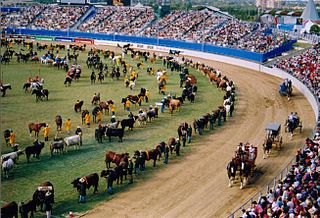
An animal show is a form of exhibition featuring the display or performance of one or more breeds of animal.

The Marine Mammal Protection Act (MMPA) was the first act of the United States Congress to call specifically for an ecosystem approach to wildlife management.

Gomphotaria is a genus of very large shellfish-eating dusignathine walrus found along the coast of what is now California, during the late Miocene.

Ontocetus is an extinct genus of walrus, an aquatic carnivoran of the family Odobenidae, endemic to coastal regions of the southern North Sea and the southeastern coastal regions of the U.S. during the Miocene-Pleistocene. It lived from 13.6 mya—300,000 years ago, existing for approximately 13.3 million years.

Hauling-out is a behaviour associated with pinnipeds temporarily leaving the water. Hauling-out typically occurs between periods of foraging activity. Rather than remain in the water, pinnipeds haul-out onto land or sea-ice for reasons such as reproduction and rest. Hauling-out is necessary in seals for mating and giving birth. Other benefits of hauling-out may include predator avoidance, thermoregulation, social activity, parasite reduction and rest.
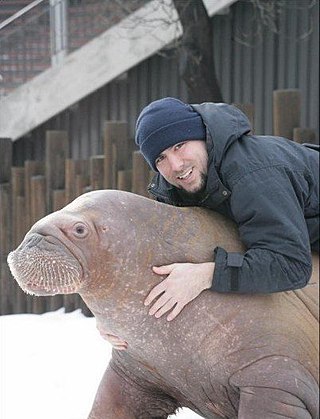
Philip Demers is a Canadian former professional marine mammal trainer at Marineland of Canada in Niagara Falls, Ontario. He is best known for his relationship with a captive walrus named Smooshi.

Pontolis is an extinct genus of large walrus. It contained three species, P. magnus, P. barroni, and P. kohnoi. Like all pinnipeds, Pontolis was a heavily built amphibious carnivore. Pontolis lived along the Pacific coast of North America along what is now the western coasts of California and Oregon between 11.608 and 5.332 million years ago, during the Miocene and Pliocene.

Albicetus is a genus of stem-sperm whales that lived during the Miocene Epoch, around 15 million years ago, and was discovered in Santa Barbara, California in 1909. It was categorized for decades as belonging to a group of extinct walruses erroneously thought to be sperm whales. It was named Albicetus, meaning "white whale", is a reference to the leviathan in Herman Melville's classic 1851 novel Moby-Dick.
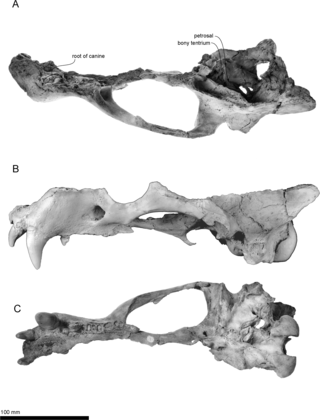
Archaeodobenus is an extinct genus of pinniped that lived during the Late Miocene of what is now Japan. It belonged to the Odobenidae family, which is today only represented by the walrus, but was much more diverse in the past, containing at least 16 genera. Unlike the modern walrus, Archaeodobenus did not have tusks but instead had canines of moderate size, and looked more like a sea lion.
Thor is the nickname of an Atlantic walrus first spotted in the Netherlands in November 2022.
